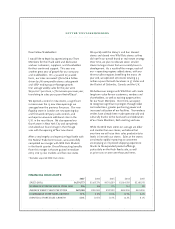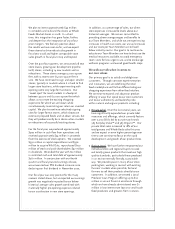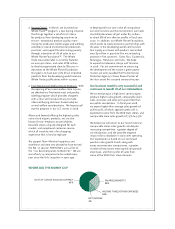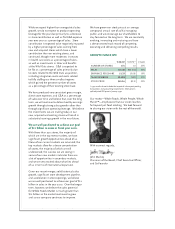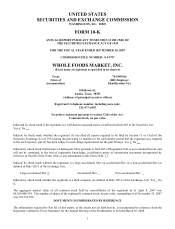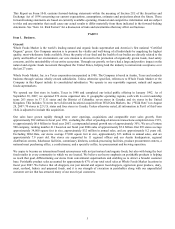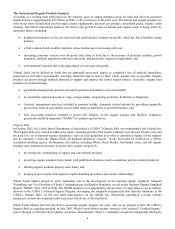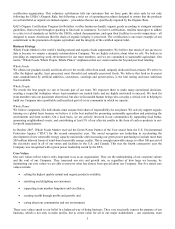Whole Foods 2007 Annual Report Download - page 13
Download and view the complete annual report
Please find page 13 of the 2007 Whole Foods annual report below. You can navigate through the pages in the report by either clicking on the pages listed below, or by using the keyword search tool below to find specific information within the annual report. 7
Quality Standards
An integral part of our Company mission is to promote the vitality and well-being of all individuals by supplying the highest
quality, most wholesome foods available. We evaluate quality in terms of nutrition, freshness, appearance and taste. Our
search for quality is a never-ending process involving the careful judgment of buyers throughout the Company.
• We carefully evaluate each and every product that we sell.
• We feature foods that are free of artificial preservatives, colors, flavors, sweeteners and hydrogenated fats.
• We are passionate about great tasting food and the pleasure of sharing it with others.
• We are committed to foods that are fresh, wholesome and safe to eat.
• We seek out and promote organically grown foods.
• We provide food and nutritional products that support health and well-being.
We monitor the production and environmental practices of our seafood suppliers and support the seafood sustainability work
of the Marine Stewardship Council. From time to time, we have stopped selling seafood species that are considered
endangered by a consensus of seafood experts.
We also strictly monitor how animals are raised and what they are fed. Our standards ensure the meat and poultry we sell are:
• raised without added growth hormones or antibiotics;
• never fed animal by-products;
• raised by farmers and ranchers who care about the animals and the environment in which they live; and
• closely monitored from the farm to our stores to ensure compliance with our strict animal welfare and food safety
quality standards.
Animal Welfare Standards
Whole Foods Market is strongly committed to helping create alternatives to the “factory farm” methods of raising livestock.
We have encouraged innovative animal production practices to improve the quality and safety of the meat and poultry sold in
our stores, while also supporting humane living conditions for the animals. For this reason, we refuse to sell commercial veal
from tethered calves, foie gras from force-fed ducks and live lobsters. In February 2007, we began working with a vendor
who meets our animal welfare standards, to sell live lobsters in our Portland, Maine store. In December 2003, we started
working through a consultative multi-stakeholder process to develop “Animal Compassionate” standards, farm animal
treatment standards that go above and beyond our baseline requirements for meat and poultry sold in our stores, focused on
providing environments and conditions for each species that support the animal’s natural physical, emotional and behavioral
well-being. In 2006, that work was then used as a basis for creating meat and poultry production standards categorized
according to a framework for continuous improvement of animal welfare on farms and ranches and to provide our customers
with a clear and transparent way to make informed buying decisions based solely on animal welfare considerations. In June
2007, we piloted a five-tiered meat and poultry labeling program at our Kensington store in London based on these
standards, which we are currently in the midst of fine-tuning and plan to roll out in the U.S. in 2008. Specific standards
related to permissible and prohibited production and handling techniques from parent stock through slaughter are intended to
be included for the following species and related products: pigs, cattle, bison, broiler chickens, ducks, goats, rabbits, sheep,
turkey, veal, dairy and eggs.
Product Categories
Our product categories include, but are not limited to: produce, seafood, grocery, meat and poultry, bakery, prepared foods
and catering, specialty (beer, wine and cheese), Whole Body (nutritional supplements, vitamins, body care and educational
products such as books), floral, pet products and household products.
Perishable products accounted for approximately 67% of our total retail sales at Whole Foods Market locations in fiscal year
2007. We believe our heavy emphasis on perishable products differentiates us from conventional supermarkets and helps us
attract a broader customer base. We believe that all shoppers, not just natural and organic food shoppers, appreciate great


